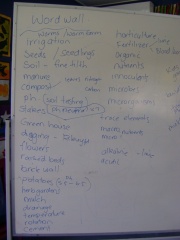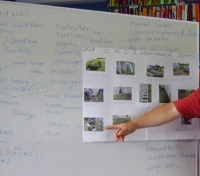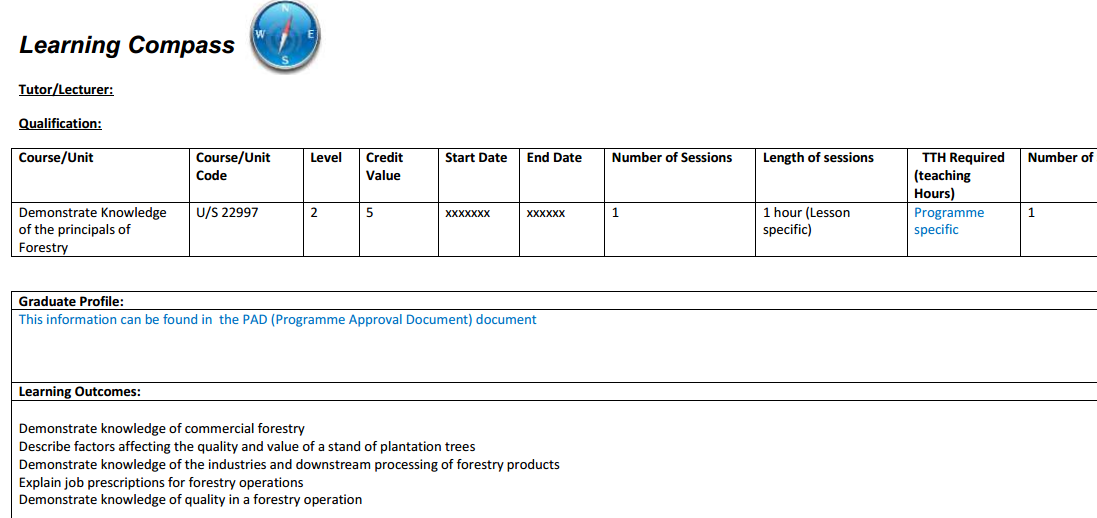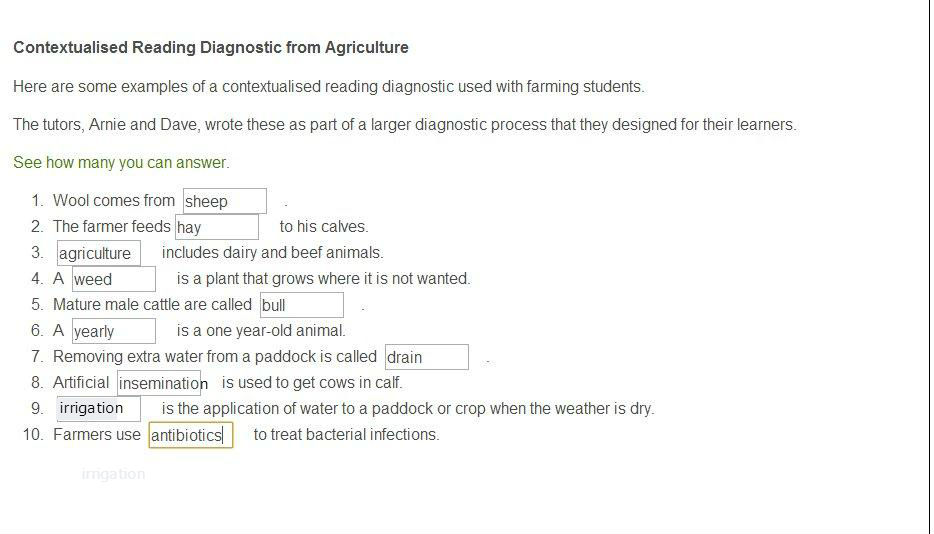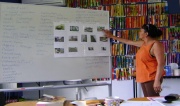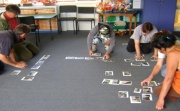User:Onlinei/User:Onlinei/Teaching literacy and numeracy to adults
Contents
- 1 Teaching literacy and numeracy to adults
- 1.1 Summary
- 1.2 Learning goals
- 1.3 Definitions
- 1.4 Overview
- 1.5 Examples of literacy activities
- 1.6 Make a learning compass
- 1.7 Contextualise your diagnostic tests
- 1.8 Examples of contextualised tests
- 1.9 Map courses and learners
- 1.10 Example of text to map
- 1.11 Create individual learning plans
- 1.12 Know what to do
- 1.13 Facilitate it
- 1.14 Assess learner progress
- 1.15 Evaluate and reflect
- 1.16 Web resources
Teaching literacy and numeracy to adults
Summary
Embedded teaching and learning combines the development of literacy and numeracy with vocational and generic skills. This page supports the teachers of adult literacy who are endeavouring to embed literacy and numeracy skills that encourage learners towards competence, confidence and the motivation to succeed in learning, at work and in life. These resources support adult educators to develop the literacy and numeracy skills of adult learners. We are happy to share these with you.
Learning goals
This page has activities and resources to help you develop understanding in these key areas:
- Get to know your learner
- Understand the literacy and numeracy demands of the programme you are teaching
- Plan and facilitate interactive learning sessions with embedded literacy and numeracy
- Analyse learner progress in literacy and numeracy
- Evaluate interactive learning with embedded literacy and numeracy
Definitions
You can use this space to learn some of the key definitions for teaching literacy and numeracy to adults in Aotearoa New Zealand.
- Ako refers to the traditional Māori thinking about the transfer and absorption of skills, knowledge, wisdom, and experience, much of which has traditionally occurred in the course of everyday activities. It implies ‘learn’ and ‘instruct’ at the same time.
- Diagnostic (assessment) refers to an assessment done to identify possible strengths and weaknesses of individual learners. It may be broad or specific and can take place at any time in a programme.
- Embed literacy and numeracy skills development refers to teaching and learning of literacy and numeracy within the context and tasks of another subject or skill, eg panel-beating.
- Formative (assessment) refers to the activities undertaken on an ongoing basis during a course or programme intended to provide feedback on progress to the learner and the educator.
- Kaitiakitanga refers to the practical doing; and rules and tikanga of adult literacy and numeracy education.
- Kōrero refers to speaking.
- Learning session is defined as a learning or training event that can be part of a course, but has its own internal coherence in terms of outcomes and subject matter coverage, and is sufficiently discrete to be able to stand on its own.
- Mana ao tūroa refers to strengthening abilities, manipulating the environment to suit personal strengths and situations, exploration.
- Mana atua refers to spirit/spirituality, well-being, sacred power of the ‘Gods’.
- Mana whenua refers to the power of the land, importance, beliefs, and belonging.
- Mana tangata refers to identity; individual cultures; the power an individual gains through their abilities, efforts, taking advantage of all opportunities, and contributing to others.
- Mana reo refers to the power or authority of language and communication, as the life force of mana Māori.
- Summative (assessment) refers to an assessment done at the end of an identified group of learning activities to establish learner achievement and to inform programme development.
- Teaching or instructional strategies refer to an approach that develops learners’ knowledge, skills and awareness, eg questioning.* Interactive learning sessions involve learners actively participating, collaborating, and interacting in the learning session. They are distinctive from presentations in that learning is facilitated through interaction, rather than lecturing.
- Tino rangatiratanga refers to determination by Māori of issues that impact on Māori; the learners’ right to define their powers of decision-making, leading to their independence.
- Titiro refers to looking, and observing.
- Tuakana-teina refers to the relationship between an older (tuakana) person and a younger (teina) person, and is specific to teaching and learning in the context of Māori. Within teaching and learning this can take a variety of forms:
- peer-to-peer: teina teaches teina, tuakana teaches tuakana,
- younger to older: the teina has some skills in the area that the tuakana does not, and is able to teach the tuakana,
- older to younger: the tuakana has the knowledge and content to pass on to the teina,
- able to less able: the learner may not be as able in an area, and someone more skilled can teach what is required.
- Whakapapa refers to genealogy, history, or stages of development. It gives a feeling of belonging, security and value.
- Whakarongo refers to listening.
- Whanaungatanga refers to nation, society, community, and relationships.
Overview
These activities and resources are designed as practical examples to help you to develop your own resources for literacy activities, making a learning compass, creating an individual learning plan, mapping courses and learners and contextualising your diagnostic tests.
Examples of literacy activities
Have a look through these literacy activities and see what you can use. There are examples of modelling paragraph writing; practice activities for speaking, listening and sequencing within a horticultural context; and an example of a synthesis chart. Dig in ....
http://wikieducator.org/File:Modelling_Paragraph_Writing.pdf
http://wikieducator.org/File:Speaking_listening_sequencing_2.pdf
http://wikieducator.org/File:Speaking_listening_sequencing.pdf
http://wikieducator.org/File:Synthesis_Chart.pdf
http://wikieducator.org/File:Word_Wall.pdf
http://wikieducator.org/File:Speaking_listening_vocabulary.pdf
Make a learning compass
Understand the learning compass better by browsing these resources:
File:Annotated Learning Compass exemplar for Chainsaw Safety.pdf
File:Embedded LN Outcomes example.pdf
File:Learning compass guidance sheet.pdf
File:Learning Compass template.pdf
Contextualise your diagnostic tests
At the beginning of a programme you will want to know the strengths and needs of your learners. Use a diagnostic assessment, for example the TEC Adult Literacy and Numeracy Assessment Tool, and a contextualised diagnostic specific to your programme.
The results of the diagnostic assessments will tell you the learners’ strengths and help you decide which literacy and numeracy skills to develop.
- Use a diagnostic assessment tool to analyse your own numeracy strengths and needs. How does it feel for you?
- Identify the adult literacy and numeracy demands of three learners by mapping your learners against the TEC Learning Progressions for Adult Literacy and Numeracy.
- Then use the resources from this course and your own research to make at least one contextualised diagnostic tool for your course or programme.
Examples of contextualised tests
Here are examples of a cloze assessment within an agricultural context, an annotated contextualised diagnostic and follow-up tests for measurement and writing within a forestry context.
http://wikieducator.org/File:AnnotatedForestryLiteracyPreTestingDiagnostic.pdf
http://wikieducator.org/File:Annotatedwritingsamplediagnostic.pdf
http://wikieducator.org/File:Horticulture_Sample_Diagnostic_Activities.pdf
Map courses and learners
Identify the most frequently used tasks and texts in your course or programme. You can map these tasks and texts using The Learning Progressions. When you have completed this mapping you can identify the skill levels that learners need to complete the course or programme.
Mapping the literacy and numeracy demands of your programme will help you analyse how to best meet your learners' needs. You can map the training, including a sample of the tasks, across the relevant strands (speaking, listening, reading, writing, numeracy, statistics and measurement) using the TEC progressions.
Identify the context-specific literacy and numeracy demands of your programme e.g technical vocabulary, complicated sentences, calculations, and prior knowledge required. A structure for this task includes:
- an outline of your training context
- programme objectives
- a written analysis of the context-specific demands of your programme.
- map two documents that your learners use on the programme against the TEC progressions to identify the literacy and numeracy demands of your programme (eg summative or formative assessment, texts)
- identify at least four context-specific literacy demands or skills of your programme. These may include reading, writing, listening, speaking, or other literacy demands. Check the TEC Learning Progressions for Adult Literacy for help.
- identify at least two context-specific numeracy demands of your programme. These may include number, statistics, measurement, or other numeracy demands. Check the TEC Learning Progressions for Adult Numeracy for help.
- compare the literacy and numeracy demands of your programme to the strengths and needs of your learners
- reflect on your decisions.
Example of text to map
Create individual learning plans
Once you have mapped your programme to know the learning demands, and you have mapped your learners, you can set individual learning plans for your learners to help fill the gaps.
- Analyse the results of your diagnostic assessment and compare the literacy and numeracy strengths and needs of your learners to the demands of your training or education programme.
- Provide literacy and numeracy focused learning plans for your learners that include the diagnostic assessment results and analysis.
- In each individual learning plan include two learning outcomes and timeframes that you have agreed upon with your learners. These will connect with your learning outcomes in your learning compass.
Know what to do
Developing teaching and learning activities is much easier when you have identified the demands of the programme and the needs of the learners. Each of the learning progressions has teaching strategies and activities that you can use in your lesson plan.
Prepare and facilitate interactive learning sessions that meet your learners’ literacy and numeracy needs by embedding literacy and numeracy skills development into the learning sessions. This means your learners will be developing their literacy and numeracy as they learn within their subject area. A combined package.
- Embed literacy and numeracy skills development into three, 30 minute, and interactive learning sessions. Each session will have different content. (eg lesson plans, or lesson plans using the learning compass template.)
- Prepare the three learning environments to meet learner needs and your intended delivery methods by considering and organising: good access to the learning environments, suitable support materials assembled (suitable for the lesson content, the number and level and type of learners), equipment checked for suitability, usability and faults, facilities booked, lay-out of learning environments is suited to participants and type of session.
- Structure the sessions so that the learning outcomes matched the learner needs. Your sessions should: aim to help the learners achieve their identified learning outcomes, match the identified needs of the learners, be timed and structured to lead from least complex to more complex principles or practice, include interaction with and between learners, include the opportunity for learners to practice or contextualise with scenarios, include an introduction or overview of what is to be covered and a reflection on what has been learned, meet the needs of different learning styles and paces, include at least one learning state change. Examples of these may include learning state changes moving from analogy or story-telling that contextualises the learning to practical demonstration of principles, or from internal to external environments, and including icebreakers, energisers, and reflective summaries.
- Select and prepare learning resources that: match two embedded literacy and numeracy learning outcomes, accommodate the expected range of learning styles of your learners. Your sessions should include the use of: audio, video, printed material, overhead projection, slides, actual objects, electronic projection, charts, whiteboard, games/simulations, ICT modalities (the way something is done with technology).
- Plan for review of: your interactive learning sessions, the effectiveness of your adult literacy and numeracy teaching strategies, the effectiveness of your adult literacy and numeracy learning activities, any specialist adult literacy support in the programme.
- The review will include: your self-reflection, collaboration with your learners for review, collaboration with your supervisor for review, established and documented criteria approved by your organisation, feedback from your learners (on: the achievement of outcomes, learning session organisation, learning session delivery, learning session content, learning environment location, learning environment interaction, assessment method), feedback from your learners and self-review of: documentation of action plans, facilitation process, provision of learner support.
- Plan for embedded literacy and numeracy skills development within the delivery of the programme’s: outcomes, teaching strategies, learning activities, resources, assessment, evaluation.
Facilitate it
Facilitate three, 30-minute, interactive learning sessions for adult learners. Consider the literacy and numeracy focused strategies you will use, including independent learning strategies and learning activities that are contextualised to learner needs. Consider tasks, texts, and any resources that support the teaching and students’ learning. Make sure you:
- Discuss embedded literacy and numeracy learning outcomes and assessment processes with the target audience and identify possible learning barriers.
- Reinforce key points during the facilitation.
- Ensure your facilitation strategies promote individual participation, group interaction, and the opportunity for learners to practice.
- Modify your facilitation as contingencies arise in the learning situation, resource availability, learner needs, and time constraints.
- Create and maintain a positive learning environment, and encourage participation, ensure resources are available, modify the pace of your delivery to suit your learner needs, ensure two-way communication is fostered and supported, monitor your learner participation with a consistent process including assessment opportunities within the learning - either formative, summative, formal or informal.
- Assess or measure learners’ achievement of the embedded literacy and numeracy learning outcomes of the session.
- Use appropriate teaching or instructional strategies.
- Ensure your learning activities: link to identified learner demands (individual learning plan), are responsive to the learners’ strengths and needs, link specific embedded literacy and numeracy activities to your programme context eg painting.
Assess learner progress
Use the same industry-specific, diagnostic, contextualised assessment tool that you used for the second, initial, pre-test assessment of your learners to reassess the same learners. You may also like to use the Learning Progressions for Adult Literacy and Numeracy as a reference. The final, post-test diagnostic assessment will assess your learners’ progress in literacy and numeracy in relation to the demands of your programme of study since the second, initial, pre-test diagnostic assessment.
Evaluate and reflect
Use the evaluation and feedback information you have gathered to reflect upon your interactive teaching sessions. Use the comparison of results between the initial and progress diagnostic assessments, which include the industry-specific, diagnostic, contextualised assessment. Evaluate the effectiveness of your literacy and numeracy teaching strategies, your learning activities, and any specialist adult literacy support occurring in the programme.
- Used stakeholder feedback to review your interactive learning sessions, the effectiveness of your adult literacy and numeracy teaching strategies, the effectiveness of your adult literacy and numeracy learning activities, any specialist adult literacy support in the programme.
- Make sure the review included: your self-reflection, collaboration with your learners, collaboration with your supervisor, established and documented review criteria approved by your organisation.
- Seek and analyse your stakeholder feedback based on the review criteria which may have included review of: the achievement of learning outcomes, learning session organisation, learning session delivery, learning session content, learning environment location, learning environment interaction, assessment method.
- Record the analyse the feedback from your learners and your self-review of your learning sessions. Your analysis should include: documentation of action plans, facilitation process, provision of learner support.
- Identify from your analysis any areas for future change or improvement, such as changes to programme and lesson planning; teaching delivery in terms of timing, resources, technology, environment, communication style, facilitation and approach.
- Identify any changes made during the programme as potential improvements for future programmes .
- Include critical reflection on the effectiveness of the teaching strategies and learning activities used.
- Confirm the effectiveness of your assessment methods.
- Include critical reflection on the management of your delivery.
- Ensure that information from your evaluation informs the planning for both your professional development and for learner literacy and numeracy skill development.
Web resources
Here's some extra resources for you: http://www.ideasthatwork.com.au/ Practical LLN tips for trainers and assessors http://www.qcal.org.au/ Tutor tips from QCAL which promotes literacy as the key to effective life-long learning for all.
http://lessonstudy.co.uk/what-works-well-case-studies/ These case studies were published on the National Strategies’ ‘What Works Well’ website. They share real examples of how learning and practice has improved through Lesson Study.
http://www.read-write-now.org/ A community based volunteer group that operates throughout Western Australia. Volunteer tutors provide free one-to-one assistance to adults wanting to improve their reading, writing, spelling and maths skills.
http://www.mathsisfun.com/mathematics-language.html

